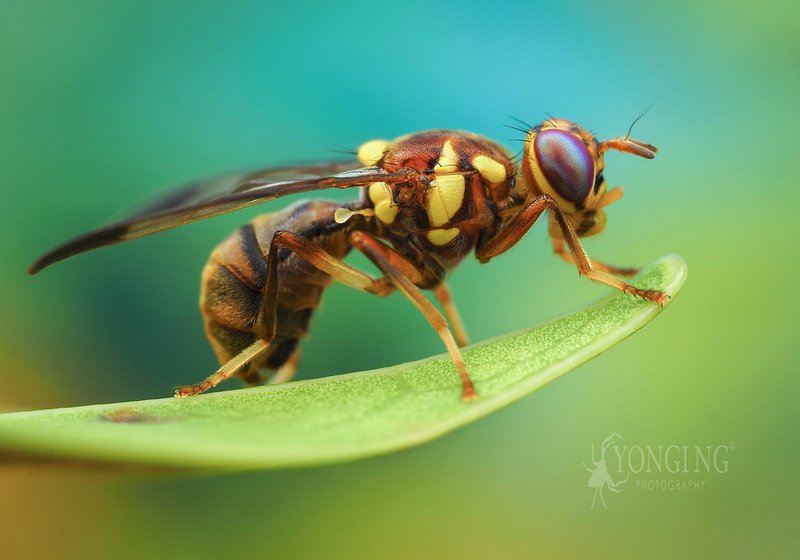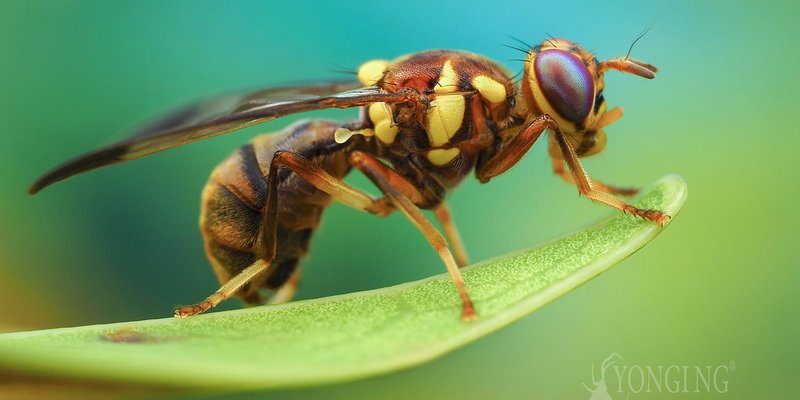
The Oriental Fruit Fly is a small yet mighty insect that can wreak havoc on fruit crops. Imagine a tiny, buzzing pest that can turn a luscious peach into a rotting mess in no time. This fly is not just a nuisance; it’s a major agricultural threat. While you might think of flies as just annoying household pests, the Oriental Fruit Fly takes its role seriously, with a knack for ruining not just fruits but also farmers’ hard work.
These flies are fascinating creatures with complex life cycles, unique behaviors, and an impressive scope of impact on agriculture. You might wonder, how can something so small cause so much trouble? Let’s dive deeper into the world of the Oriental Fruit Fly, exploring everything from its biology to its impact on agriculture and effective control methods.
What is the Oriental Fruit Fly?
The Oriental Fruit Fly, scientifically known as Bactrocera dorsalis, belongs to the family Tephritidae. It’s widespread across Asia, Africa, and even parts of the Americas. Its body is typically a striking yellowish-brown, adorned with distinctive black markings that make it somewhat attractive despite its destructive tendencies. Adult flies measure about 8 to 10 millimeters in length, not much larger than a regular fruit fly.
One of the most remarkable aspects of the Oriental Fruit Fly is its ability to adapt and survive in various climates. While they thrive in tropical regions, their presence has been noted in subtropical and even temperate zones. This adaptability is one reason why they can invade new areas so swiftly, often establishing themselves in regions where they weren’t previously found.
The fly’s life cycle is equally captivating. It begins as an egg laid inside a ripe fruit. Within a week, these eggs hatch into larvae, which then feast on the fruit’s flesh. This feeding process creates a perfect environment for diseases and fungal infections, making the fruits unmarketable.
Characteristics of the Oriental Fruit Fly
Understanding the Oriental Fruit Fly’s physical attributes and behavioral patterns can help us appreciate why it’s such a formidable pest. The adults have striking features—large, complex eyes and patterned wings that can be mistaken for those of a butterfly. They’re agile flyers and can often be seen darting rapidly around fruit trees, especially during warm weather.
| Size: | 8–10 millimeters |
| Color: | Yellowish-brown with black markings |
| Habitat: | Tropical and subtropical regions |
| Life Cycle: | Egg, larva, pupa, adult (approx. 30 days) |
| Diet: | Fruit (mangoes, papayas, peaches, etc.) |
| Known For: | Causing significant agricultural damage |
Another interesting characteristic of the Oriental Fruit Fly is its reproductive strategy. A single female can lay up to 1,000 eggs in her lifetime! This prolific breeding can quickly lead to population explosions, making it essential for farmers to stay alert for signs of these pests.
Life Cycle of the Oriental Fruit Fly
The life cycle of the Oriental Fruit Fly is a perfect example of how nature works in cycles. It begins when a female fly lays her eggs inside a host fruit. This isn’t just any random fruit; the fly has particular preferences, favoring ripe and decaying fruits that offer the best nutrients for her offspring. Once the eggs hatch, the larvae burrow into the fruit, where they continue to develop.
After approximately ten days as larvae, they emerge to pupate in the soil. This pupal stage lasts anywhere from a few days to a couple of weeks, depending on environmental conditions. Finally, the adult fly emerges, ready to continue the cycle. It’s a remarkably efficient process that underscores why this species can spread so rapidly, especially in fruit-rich regions.
Each stage is vital, contributing to both the fly’s survival and the challenges it poses to agriculture. Farmers must be vigilant, monitoring their crops not only for the flies but also for the signs of larvae and damage. You might even see farmers using traps or baits designed specifically to attract these pesky flies, effectively breaking the cycle before it spirals out of control.
Impact on Agriculture
When it comes to agriculture, the Oriental Fruit Fly can be a disaster. Its destructive feeding habits are not just bothersome; they result in significant losses for fruit growers worldwide. The flies don’t discriminate—they attack a wide range of fruit, including mangoes, avocados, and citrus. A single infected fruit can lead to spoilage of an entire batch, ruining harvests and hurting farmers’ incomes.
The economic impact is staggering. In some regions, farmers may lose up to 80% of their harvests if infestations go unchecked. The cost of control measures can also add up, leading to financial strain. Farmers often find themselves caught between the continual struggle to protect their crops and the financial realities of pest control.
Moreover, the presence of the Oriental Fruit Fly can lead to restrictions on trade. Countries may impose strict quarantine measures, making it difficult or even impossible for farmers to export their produce. It creates a ripple effect, impacting not just individual farmers but entire communities that rely on fruit agriculture for their livelihoods.
Control Measures
Effective control of the Oriental Fruit Fly requires a multi-faceted approach. Farmers need to implement integrated pest management (IPM) strategies, which combine different methods for the best results. Traps can be set up to monitor fly populations and catch adults before they mate and lay eggs.
Another strategy is to use baits and lures that specifically attract the Oriental Fruit Fly. These baits often contain pheromones, which are chemicals the flies use to communicate. By mimicking these signals, farmers can draw flies into traps and reduce their numbers. You might want to imagine it like a party where only the flies are invited—everyone else just gets to enjoy the peace and quiet.
Additionally, removing overripe or damaged fruit from orchards can help break the fly’s life cycle. By keeping fruit trees clean and healthy, farmers can reduce available breeding sites, making it harder for the flies to thrive. Education and awareness are key; farmers sharing information can collectively fight against this pest more effectively.
Environmental Impact
The impact of the Oriental Fruit Fly extends beyond agricultural economics; it can also have significant environmental implications. As these flies invade new regions, they can disrupt local ecosystems. In areas where they thrive, native fruit-eating species may struggle as competition for resources increases.
This disruption can lead to a cascade effect, impacting not just fruit trees but entire food webs. Insects and birds that rely on certain fruits for food may find their diets compromised. This highlights the importance of managing not just the fly but the overall health of the ecosystems where they invade.
Additionally, the measures taken to control the Oriental Fruit Fly may also have unintended consequences on the environment. For example, pesticides used to combat these pests can affect non-target species, including beneficial insects. It’s crucial that all control measures are evaluated for their ecological impact to ensure a balanced approach to pest management.
FAQ
What are the signs of an Oriental Fruit Fly infestation?
Signs of an Oriental Fruit Fly infestation include fruit that has small puncture wounds, the presence of larvae inside damaged fruit, and the appearance of rotting fruit on the ground. If you notice these signs, it’s time to take action to protect your crops.
Can Oriental Fruit Flies affect vegetables?
Oriental Fruit Flies primarily target fruit, but in some cases, they can also infest certain vegetables, particularly those with soft skins. However, they are not as damaging to vegetables as they are to fruits. Monitoring is essential to keep these flies at bay.
How can I naturally deter Oriental Fruit Flies?
There are several natural deterrents for the Oriental Fruit Fly. You can use essential oils, like peppermint or clove, in sprays to repel them. Another effective method is to keep your garden clean by removing overripe and damaged fruits that attract flies.
Are there any natural predators of the Oriental Fruit Fly?
Yes, natural predators such as certain parasitic wasps can effectively control Oriental Fruit Fly populations. These wasps lay their eggs inside the fly’s larvae, effectively reducing their numbers. Creating a biodiverse environment can enhance the presence of these beneficial insects.
What fruit is most affected by the Oriental Fruit Fly?
The Oriental Fruit Fly has a wide preference for many fruits, but mangoes, peaches, and avocados are particularly susceptible. Farmers who grow these fruits should remain vigilant and implement control measures promptly.
Can Oriental Fruit Flies survive in cold climates?
While they prefer warm, tropical regions, Oriental Fruit Flies can survive in cooler climates for short periods. However, their populations tend to decline during colder months, making them less of a problem in winter.
How fast can Oriental Fruit Fly populations grow?
Oriental Fruit Fly populations can grow rapidly. Under optimal conditions, a single female fly can lay hundreds of eggs, and within weeks, those eggs can hatch into larvae that begin feeding. This cycle can lead to significant increases in population size within a few months.
Is it safe to use traps around pets?
Most traps designed to catch Oriental Fruit Flies are safe to use around pets when used as directed. However, it’s always best to place traps in areas where pets can’t access them. Always check the product’s safety information to ensure your pets are safe.
Can home remedies be effective against Oriental Fruit Flies?
Yes, home remedies such as vinegar traps can be effective. Mixing apple cider vinegar with a few drops of dish soap can trap flies. The vinegar attracts them, while the soap prevents escape. This is a simple and chemical-free way to manage small infestations.
What’s the best time of year to monitor for Oriental Fruit Flies?
Monitoring for Oriental Fruit Flies is best done during the warmer months, primarily from spring to late summer. This is when their populations are at their peak, and if you can detect them early, control measures can be more effective.
Do Oriental Fruit Flies only attack ripe fruit?
While they prefer ripe fruit, Oriental Fruit Flies can also lay eggs in overripe or damaged fruit. Monitoring your crops regularly and harvesting fruits promptly can help prevent infestations.
What should I do if my crops are infested?
If your crops are infested, it’s important to take immediate action. Remove and destroy any infested fruit, set traps, and consider using organic pesticides if necessary. Consulting with agricultural extension services can also provide specific strategies for your area.
How do I distinguish Oriental Fruit Flies from other fruit flies?
To distinguish Oriental Fruit Flies from other species, look for their unique yellowish-brown coloring and patterned wings. They also tend to be slightly larger than common fruit flies. Examining their behavior and preferred host fruits can also help identify them.

